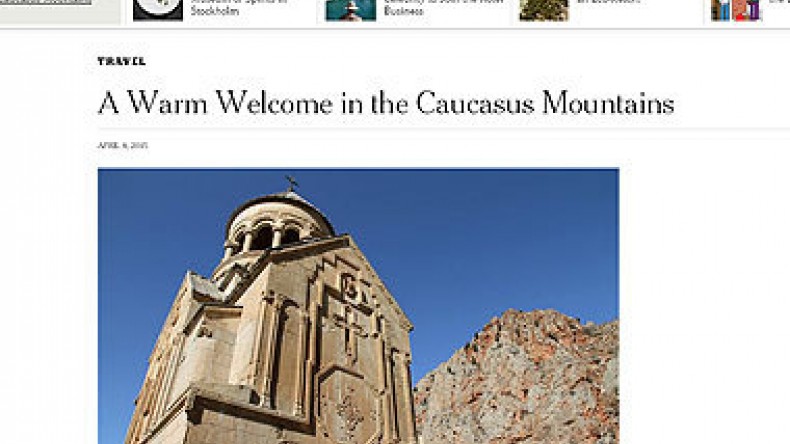
The New York Times: Nagorno Karabakh is beautiful to look at, miserable to conduct war in
The clotheslines that extended from balconies in Stepanakert showed an extraordinary degree of precision, if not obsession. In this city of 50,000, families ordered the clothes by color and by size. Could it be that living in the limbo of a self-declared but largely unrecognized country drives people to seek order in other ways? Seth Kugel ponders on this question in his article “A Warm Welcome in the Caucasus Mountains’’ published on the website of the newspaper The New York Times.
In his article Kugel tells about his weekend spent in Nagorno Karabakh, where about 150,000 Armenians live over 4,400 square kilometers of mountains, rivers and valleys in the Caucasus Mountains. To the west is an easygoing border with Armenia; to the east is a disputed boundary with Azerbaijan, which sees regular sniper attacks and, last year, a downed helicopter incident. The area’s complicated history goes back centuries. Most recently, a bitter war in the early 1990s, in which the Armenian-majority enclave declared independence and a new constitution in 2006 declared it a sovereign state.
As the article has it, although Nagorno Karabakh Republic is not recognized by any member of the United Nations, it has its own flag and government, and is deeply connected with Armenia. Kugel also highlights that trip to Nagorno-Karabakh is excellent for travelers on a tight budget. He spent there about 47,000 drams (almost exactly $100), half of which covered his transport costs.
The traveler tells that in the taxi he made friends with Sonya Varoujian, who grew up in London and New York, and Goreun Berberian, a Syrian Armenian. Both are descendants of Armenians who fled the Ottoman Empire during the genocide a century ago.
''We stopped in a field to widen our eyes at the enormity of Mount Ararat, its two mismatched humps rising ethereally above the haze, and at Noravank, one of Armenia’s many strikingly situated monasteries, its stone churches matching the rust-colored cliffs it was nestled in. ‘It’s one of the newer ones,’ said Sonya, which in Armenia means it was built just in time to be sacked by Mongols in the 13th century,” Kugel writes.
In Stepanakert, in the shop of a talented jewelry-maker, Armond Tahmazian, who came from Iran in 1999, Kugel tasted homemade grape vodka and toasted “to the boys,” who had fought in the war. In the cafe Evita he tried the ''epitome'' of Karabakh cuisine: zhingyalov hats - over 11 greens folded in paper-thin flatbread.
The next destination after Stepanakert, the capital of NKR, was Shushi - a partly walled hilltop city that has seen plenty of sieges in its time, most recently its capture by the Armenians in 1992, a key and still celebrated victory of the war. On the drive up, there is a memorial featuring the first Armenian tank to enter the city. In the city, along with partly renovated buildings, two mosques stand out. Though Armenians are Christians, the mosques used by Azerbaijani Muslims a quarter-century ago are surprisingly intact and lovely. Then the traveler found out later that the Armenians had protected and restored 19th-century Upper Mosque.
Later, with Sonya’s friends, Sevak and Davit, they went on a hike to Hunot Gorge. “After buying elements for a barbecue — meat, big ovals of matnaqash bread and vodka (plus water, my idea) — we realized we didn’t have skewers. Davit simply walked over to a nearby apartment building, started shouting up to people on the balconies, and soon returned with skewers on loan from a stranger,” Kugel relates.
The narrow but spirited Karkar River rushing through the gorge; across, a hill covered by slender trees that, leafless in winter, looked like porcupine quills, snow-capped mountains stretching to the horizon… “Beautiful to look at, miserable to conduct a war in,” the traveler thought looking around.
Passing the bridge, the group found the astonishing Zontik, or “Umbrella,” waterfall. To Kurgel the rock formation looked more like a bunch of giant mushrooms, drooping over a shallow cave. “The rocks were covered in green moss, which split the water into tiny streams, forming a sheet of rivulets covering the entrance to the cave like a beaded curtain,” Kugel describes.
The next morning he left Nagorno Karabakh with a sense of frustration at their incredibly abbreviated visit to a beautiful and complicated place and with a lesson: a day and a half is way too short to see an entire country.
Related:
Argentinian media: Immersed in cozy landscape around Gandzasar it is hard to believe that contact line is within hour’s drive
TV channel BBC tells about Armenians’ lives in NKR under Azerbaijan’s permanent threats
British Journal: Nagorno Karabakh populated with Armenians could become the new wonder of world
Newsfeed
Videos






























